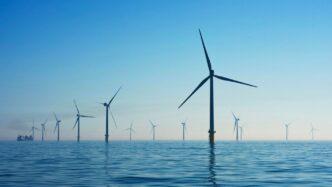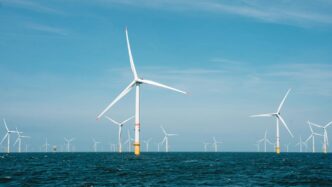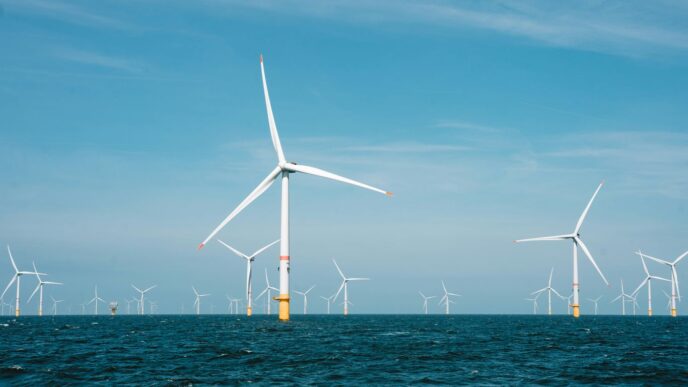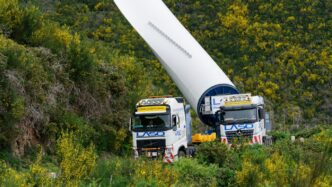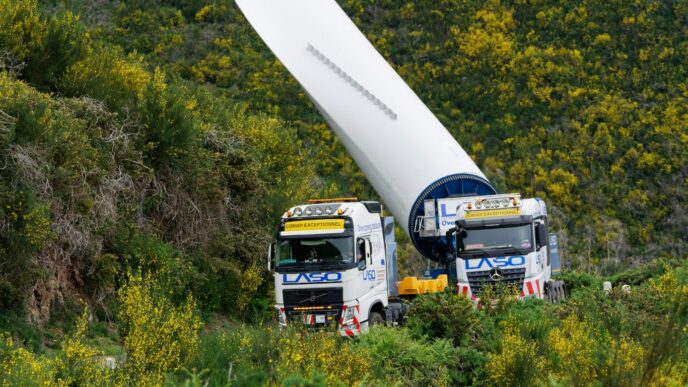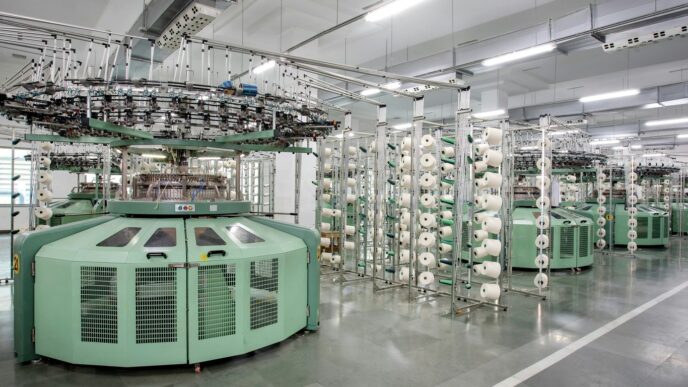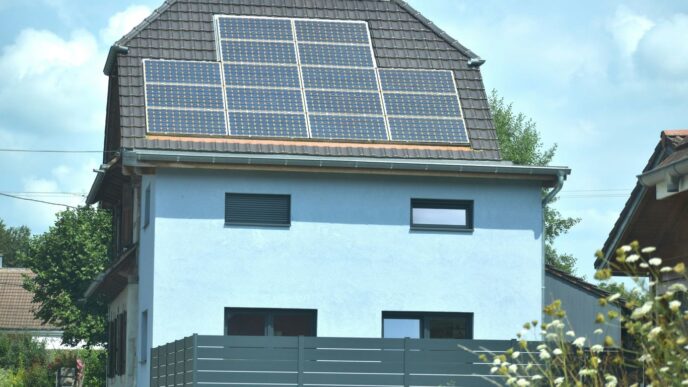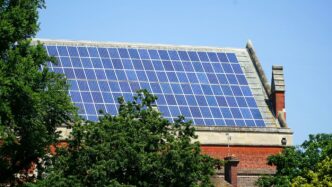Keeping up with the latest offshore wind farms news can feel like a full-time job. Projects are popping up all over the globe, from Europe to North America and Asia. We’re seeing big investments, new tech, and of course, some challenges along the way. Let’s take a quick look at what’s been happening lately in the world of offshore wind.
Key Takeaways
- Poland’s Baltyk 2 and 3 offshore wind farms are making good progress, with key construction steps being completed.
- The South Fork Wind Farm is now fully operational, adding significant power capacity in the US.
- Ocean Winds has sold a portion of its stake in a French offshore wind project as it nears completion.
- The UK’s offshore wind sector is facing funding concerns, with recent budget decisions drawing criticism.
- New infrastructure and technology, like XXL monopiles and advanced grid connections, are supporting the growth of offshore wind.
European Offshore Wind Project Milestones
Progress on Poland’s Baltyk 2 and 3 Offshore Wind Farms
Things are moving along nicely with the Baltyk 2 and 3 offshore wind farms in Poland’s Baltic Sea. The developers have reported that several important steps have been completed. Recently, the initial geological and seismic surveys of the seabed wrapped up. This is a big deal because it means the project is getting ready for the next stages of development. It’s good to see these large projects making steady headway.
‘Advanced’ Polish Wind Farm Moving Ahead at Pace
One of Poland’s most modern offshore wind farms is progressing right on schedule. The main contractor for the project has confirmed that construction is moving forward as planned. This project is considered quite advanced, and its steady pace is a positive sign for the region’s renewable energy goals. It shows that complex offshore projects can keep to their timelines when managed well.
First Transformer Installed at Baltica 2 Offshore Substation
Big news from the Baltica 2 offshore wind farm! The first transformer has now been installed at its offshore substation. This is a significant step in getting the power from the wind turbines ready to be sent to shore. They’re also planning to install what’s being called the industry’s first fully electric jib cranes at this substation, which is pretty neat. This shows a commitment to using newer, more efficient technology in these massive projects.
North American Offshore Wind Developments
Things are really picking up speed on the offshore wind front here in North America. It feels like just yesterday we were talking about the very first projects, and now we’ve got several fully operational and a whole lot more in the works. It’s pretty exciting to see this industry grow.
South Fork Wind Farm Fully Operational
Big news out of New York: the South Fork Wind Farm is now officially up and running. This project is a pretty significant step, adding 132 MW of clean power to the grid, enough to power about 70,000 homes on Long Island. It uses 12 turbines, and it’s great to see it contributing to the state’s renewable energy goals. This really shows that large-scale offshore wind is not just a future possibility, but a present reality.
Coastal Virginia Offshore Wind Pilot Project Update
Dominion Energy’s Coastal Virginia Offshore Wind (CVOW) pilot project, which was the first to be built in federal waters, continues to operate. While it’s a smaller pilot project at 12 MW, it paved the way for much larger developments. The real story here is the massive 2.6 GW CVOW project that’s currently under development, which will be one of the largest in the world once completed. It’s a huge undertaking, and progress is being made, though these massive projects always have their complexities.
Block Island Wind Farm Continues Operations
The Block Island Wind Farm, America’s very first commercial offshore wind project, is still chugging along. It came online back in 2016 and has a capacity of 30 MW. While it’s small by today’s standards, it was a groundbreaking achievement. It proved that offshore wind could work in the U.S. and served as a vital learning experience for the industry. It’s a testament to the technology and a reminder of how far we’ve come in just a few years.
Global Offshore Wind Industry Investments
Ocean Winds Sells Stake in French Offshore Wind Farm
Ocean Winds, a major player in the offshore wind game, has recently sold off a portion of its stake in a 488MW wind farm located in France. This move comes as the project is getting pretty close to finishing up construction. It’s a sign that even big companies are adjusting their holdings as projects mature. Selling a stake can free up capital for new ventures or help manage risk. It’s not uncommon to see this happen, especially when a project is moving from the development and construction phase into full operation.
Taiwanese Firm Awarded Contract on 1GW Offshore Wind Project
Things are really heating up in the offshore wind sector, and this time the spotlight is on Taiwan. A local firm there has landed a significant contract for a massive 1-gigawatt offshore wind project. This kind of deal is a big deal, not just for the company involved but for Taiwan’s growing role in the global renewable energy market. Landing a contract for a project of this size means a lot of work, investment, and likely job creation. It shows that the region is becoming a serious contender in supplying the components and services needed for these enormous wind farms.
Dutch Port Receives Millions for Offshore Wind Upgrade
A port in the Netherlands is getting a substantial financial boost, to the tune of millions, to upgrade its facilities for offshore wind operations. Ports are like the staging grounds for these massive projects – they need to be able to handle huge components, support construction crews, and manage logistics. This investment means the port is getting ready for more offshore wind activity, which is great news for the local economy and the broader renewable energy supply chain. It’s all about making sure the infrastructure is in place to support the growing demand for wind power generated at sea.
UK Offshore Wind Sector Challenges

Funding Concerns for UK Offshore Wind Development
The UK’s offshore wind sector is facing some serious headwinds when it comes to funding. The latest budget from the Department for Energy Security and Net Zero has left many in the industry feeling pretty disappointed. The numbers announced for the upcoming Allocation Round 7 just weren’t what people were hoping for, especially considering how much investment is needed to keep these massive projects moving.
It feels like a step backward for a sector that’s hungry for consistent financial backing. This lack of robust funding can make it tough for developers to commit to long-term projects.
Advocates Decry Budgetary Shortfalls for Offshore Wind
People who are really pushing for offshore wind in the UK are speaking out about the budget situation. They’re saying the funding that’s been laid out just isn’t enough to keep the momentum going. It’s not just about building new farms; it’s about making sure the whole supply chain is strong and ready for the future.
Here’s a look at some of the issues:
- Investment Uncertainty: When budgets are lower than expected, it creates uncertainty for investors. They might start looking elsewhere if they don’t see a clear, well-funded path forward.
- Supply Chain Strain: The UK has been trying to build up its own supply chain for offshore wind components. Without enough government support and clear project pipelines, these domestic businesses struggle to get the investment they need to grow and compete.
- Pace of Development: The UK has ambitious climate goals, and offshore wind is a big part of that. If funding falls short, it can slow down the pace at which new wind farms can be developed and brought online, potentially impacting those targets.
There’s a real push for a "new deal" for the North Sea, as some ministers are calling it, to get everyone on the same page and give investors more confidence. It’s a complex situation, but getting the funding right seems to be the biggest hurdle right now.
Offshore Wind Infrastructure and Technology
XXL Monopiles Shipped for Inch Cape Offshore Wind Farm
Getting these massive wind turbines out into the ocean is no small feat. We’re talking about some seriously huge pieces of equipment. For the Inch Cape Offshore Wind Farm, they’ve been shipping out these things called "XXL monopiles." These are basically giant steel tubes, and they’re the foundation that holds up the wind turbine towers. They’re so big, they have to be transported on special barges and put in place using some pretty impressive cranes mounted on ships. It’s a whole operation designed to handle the rough conditions out at sea.
Germany’s Newest Offshore Grid Connection Comes Online
So, you’ve got all these turbines out there spinning, but how does that power actually get to your house? That’s where the grid connection comes in. Germany just brought a new one online, and it’s a pretty big deal. It’s basically a superhighway for electricity from the wind farm to the mainland. This involves a whole network of cables, including inter-array cables that link the turbines together and then a big export cable that runs under the seabed all the way to shore. Once it hits land, it goes through another substation to get it ready for the regular power lines.
Offshore Wind Turbine Drivetrain Designs Explained
Inside each wind turbine is a complex system called the drivetrain. This is what takes the spinning motion of the blades and turns it into electricity. There are a few different ways companies design these drivetrains, but the main idea is always the same: use the wind’s energy to spin a generator.
Here’s a quick rundown of what happens:
- Wind hits the blades: The wind pushes against the large blades, making them rotate.
- Rotation powers the drivetrain: This spinning motion is transferred through various gears and components within the drivetrain.
- Generator creates electricity: The drivetrain’s motion spins a generator, which produces electrical power.
- Power is converted and sent: The electricity is then converted from DC to AC and sent through cables, first to an offshore substation and then via export cables to the shore.
Economic Impact of Offshore Wind
Building out the offshore wind industry in the U.S. is shaping up to be a pretty big deal for the economy. We’re talking about creating a whole new supply chain right here at home, which means a lot of jobs. Think manufacturing, port upgrades, specialized vessels, and training programs. It’s not just about the big picture either; these projects are expected to breathe new life into coastal communities, bringing in investments and boosting local economies. Some early estimates suggest over $4 billion could be poured into manufacturing, ports, vessels, and workforce development, with more on the way. It’s a generational opportunity, really.
Building America’s Offshore Wind Project Pipeline
Getting these massive wind farms off the ground involves a lot of moving parts. It’s not just about putting turbines in the water. We’re looking at developing new manufacturing facilities, expanding port infrastructure to handle huge components, and building a fleet of specialized ships. This pipeline is projected to create tens of thousands of jobs across the country. It’s a complex process, but the payoff in terms of economic activity and clean energy generation is substantial. The goal is to have a robust domestic industry that can support this growing sector.
Job Creation and Local Economic Stimulation
So, what kind of jobs are we talking about? It’s a wide range, from highly skilled engineers and technicians working on turbine design and maintenance to construction workers building foundations and installing equipment. There are also jobs in manufacturing the components, operating and maintaining the vessels, and managing the projects. Beyond the direct jobs, there’s a ripple effect. Local businesses can benefit from increased demand for goods and services, and communities can see new tax revenues. It’s estimated that the industry could support around 56,000 U.S. jobs with projected investments of $65 billion by 2030. That’s a significant economic boost.
New American Supply Chain Development
For a long time, a lot of the components for large-scale energy projects had to be imported. Offshore wind is changing that. There’s a big push to develop a domestic supply chain, meaning more manufacturing will happen here in the U.S. This includes everything from the massive steel towers and blades to the complex electrical systems and undersea cables. Building this supply chain not only creates jobs but also makes the U.S. more self-sufficient in energy production and less reliant on foreign suppliers. It’s about building long-term economic strength and technological know-how right here at home.
Navigating Offshore Wind Resources
Support Offshore Wind Resources
So, you want to know more about offshore wind energy in the U.S.? It’s a pretty big deal, and there are some great places to get the lowdown. SupportOffshoreWind.org is a good starting point if you’re curious about how this whole sector is set to grow. They’ve got videos, articles, and reports, plus you can sign up for updates. It’s all about how offshore wind can help the economy, create jobs, and bring clean energy to folks across the country.
American Clean Power Association Resources
The American Clean Power Association (ACP) also puts out a lot of useful stuff. You can grab their latest fact sheets, reports, and studies right from their website. If you want to stay in the loop weekly, sign up for their Offshore Wind Weekly e-brief. It’s a quick way to get the news delivered straight to your inbox. They cover what’s happening in the industry, so you don’t have to hunt for it.
Bureau of Ocean Energy Management Information
Then there’s the Bureau of Ocean Energy Management (BOEM). They’re a key government agency, and they have a bunch of resources that are pretty informative. Here are a few things you might want to check out:
- 2016 National Offshore Wind Strategy: This gives you a look at the government’s long-term plan.
- BOEM Offshore Wind Energy: General information about their role and activities.
- BOEM Offshore State Activities: Details on what’s happening state by state.
- BOEM Offshore Leases Fact Sheet: Explains how leases are awarded and managed.
- BOEM Renewable Energy Fact Sheet: Broader context on renewable energy projects they oversee.
These resources can help you get a clearer picture of the regulatory side and the areas being considered for development. It’s a lot to take in, but these sites are designed to make it easier to understand.
Wrapping Up the Offshore Wind Scene
So, that’s a quick look at what’s happening in the world of offshore wind. We’ve seen projects moving forward in places like Poland and France, with big investments being made. Even old sea mines are being cleared out to make way for these new farms! The U.S. is also getting in on the action with a few projects already running and more planned. It seems like a lot of countries are really pushing for this kind of energy, which is good for jobs and for the planet. Keep an eye on this space, because it’s definitely growing.

